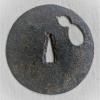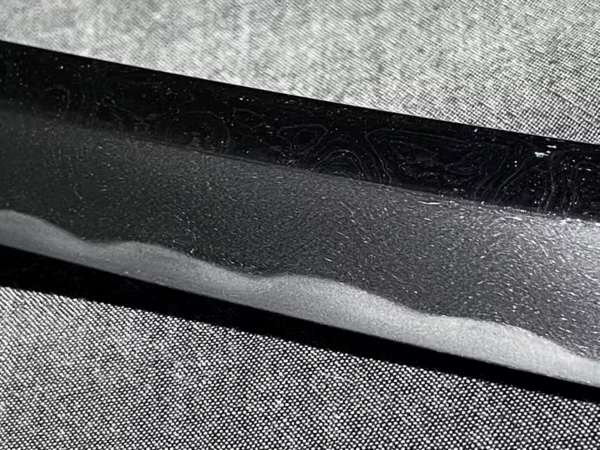-
Posts
52 -
Joined
-
Last visited
About YourBabyBjornBorg

Profile Information
-
Location:
Szechuen, PRC
-
Interests
Fine dining in general, wine, nephrite, antique Chinese porcelain, and Nihonto.
Profile Fields
-
Name
Baby Joe
Recent Profile Visitors
711 profile views
YourBabyBjornBorg's Achievements
-
YourBabyBjornBorg started following Help with identification and thoughts , translation requested , Rust under control? and 6 others
-
.thumb.png.54593db2789c8a1dcb235543b184ce39.png)
Can't read the number on the torokusho
YourBabyBjornBorg replied to Moritsuchi's topic in Translation Assistance
The Sori on this Torokusho is “なし/None”. -
.thumb.png.54593db2789c8a1dcb235543b184ce39.png)
Identify the markings on this katana
YourBabyBjornBorg replied to NomiHaku's topic in General Nihonto Related Discussion
Hi! This is 則光/Norimitsu. -
.thumb.png.54593db2789c8a1dcb235543b184ce39.png)
Found this in the wall
YourBabyBjornBorg replied to stuckineriver108's topic in Translation Assistance
This is 備前国長舩住祐定作/Bizen no Kuni Osafune-Ju Sukesada Saku. -
Hi! This looks like a 兼友/Kanetomo. Edited: A 友 with an extra dot on the upper-right is one of the older ways to write 友, first seen usage from at least the end of the Three Kingdoms time(220 AD~). All of these are from the Tang dynasty (618 - 907 AD), though. It seems that Koto period Kanetomo uses this version more often, with occasional regular 友. (Picture from "Encyclopedia of Mino-Tou")
-
.thumb.png.54593db2789c8a1dcb235543b184ce39.png)
Help with identifying the markings on this sword.
YourBabyBjornBorg replied to Dave69's topic in Nihonto
This is upside down. This reads "石鳥マキ(Ishitori/Sekicho Maki)". 石鳥 could be Ishitori or Sekicho. Edited: Woops! I forgot to mention that this is likely someone's name, not the signature of the swordsmith. "Maki" is usually feminine, but could work as a masculine name, too. -
Wow! That's a huge number of pre-Edo Gassan signatures! Yes, I understand there is huge variance in accepted Gassan signatures, so not finding anything like this in a very small sample pool of 10+ signatures is not the end. I think I even saw one where the character 月 looks like it's lying down on the ground, very weird indeed.
-
Thank you! Oh, I know this one by the NHTHK! "刀 銘 月山 (と銘がある・室町時代)/ Katana Mei Gassan (To Mei Ga Aru, Muromachi period)", for when it is Gimei, but it's correct about the attribution. Sadly, there is no photo that shows Sugata well, the first one is the best one we have here, and from the looks of it, it's not from late Nanboku-Cho, when one of the earliest signed Gassan, the only designated Important Art Object, is attributed to. it looks a little Koshi-Zori, and if this is indeed Muromachi, then there should be a little Saki-Zori, too. (Typical Muromachi Tachi Sugata, with both Koshi-Zori and Saki-Zori. I chuckled a little when I first saw one referred as such in a book.) Still, a possible or controversial Gimei is as bad as Mumei to me, and I would also hesitate to spend almost 5 grand just to find out what NHTHK would make of this.
-
Indeed. I would assume this sword failed its Shinsa at NHTHK, and that's why it's without paper and at this price. (I'm not sure if this sword is physically in PRC, though. Dealers here rarely photograph swords this well. These photos could be from a Japanese dealer.) And yes, the Hada on the Shinogi is almost as clear as below. Not impossible for a traditionally polished sword, but also a little suspicious.
-
Greetings, good people of Nihonto Messege Board! I always thought my very first topic would be in the Izakaya forum, where I finally introduce myself, a random person just all of a sudden showed up there and started typing random stuff, properly to everyone, and more importantly explain in what kind of stage of Japanese Swords learning I am, but I just can't resist sharing this peculiar sword I saw tonight with everyone, alongside a very little research of my own on signed Gassan. (Multiple sources in PRC posted this for sale at 4600 dollars americano without any certification, but I don't know if the sword itself is in PRC.) As we can all see, this is indeed a very beautiful Ayasugi-Hada sword. However, as is one of the conundra of Japanese Swords appraising, a precious Koto with very fine Hada is sometimes rather hard to tell from a Shinto or even Shinshinto, and I am truly stumped by this. There are so many schools that make Ayasugi-Hada swords throughout the history of Japanese swords, Gassan, Mokusa, Naminohira, Hoju and so on, even the later appointed Living National Treasure, Gassan Sadaichi, was once a known Gimei maker in the record of Fujishiro Yoshio Sensei. As for the signature, I compared this with more than ten different signed Gassan including a designated Important Art Object, but failed to find anything alike. However, it suddenly dawned on me that there might be something wrong with this Nakago. If this is indeed from the early Muromachi period, like the signature implied, then there should be more pitting corrosion and rusting in general on the outskirts of Nakago than the inside, a phenomenon that, if we pay enough attention, is then everywhere to be found on Japanese swords, even with Shinshinto or Gendaito from Showa. (I first learned this in Nakahara Nobuo Sensei's book. Yes, I am aware that many of his views are highly controversial, but he does have some valid points on spotting Gisaku.) This Nakago, however, is suspiciously evenly rusted, and almost without any pitting corrosion. If this Nakago is tempered with artificial rust, then the authenticity of its signature is in question, too. Because I have great concern about the whole Mumei Kiwame system, It has always been my dream to obtain an affordable, signed, and most importantly, stunning Koto before Muromachi, this sword looked like it at the beginning, but I am afraid I will have to dream on. What do you think of this sword? Is the Kitae-Hada Koto-like? Does the Nakago look at least 400 years ago? Do please share your precious opinion. Thank you! (Some would argue that Utsuri is a telltale sign of Koto, but I think someone capable of making this stunning sword would also be able to make Utsuri, just like people in Shinto, Shinshinto or even Gendaito period.)
-
First a little detour, because just 30 minutes ago I studied quite a number of authentic signed Ko-Gassan for an unpapered one, apparently there is even a signed Nagamitsu from Ko-Gassan school (and it's a Juyo, too). It was mentioned in "Swords' Talk with Kunzan/薫山刀話", then I saw its Oshigata in "Random Thoughts of Nihonto/日本刀随感" by Kataoka Sensei. Besides the one great swordsmith we all know and love that brought great fame and honour to it, Nagamitsu/長光 is just a very auspicious name for swordsmiths, meaning "to shine for a long time (長く光る)", so no wonder many smiths happen to choose it for their name, in different times and places. Edited: Now that I had a few minutes to look at the first sword on Aoi san, I would say that's a very typical Prison Nagamitsu, and almost every traits of it point to this same conclusion. It is unfortunate that I cannot develop my statement without detailing how the many less-than-ideal characteristics of this sword lead to this result and being rude to it. Although this reminds me of what Fukami san of Choshuya said, (paraphrasing) "make sure the signature is the last thing you look at when telling where, when, and by whom a sword is made.", suggesting we put Sugata, Ha, Ji and other attributes, i.e., what the sword really is, in front of the mere signature when appraising a sword. Anyway, just some random thought. Not nearly as good as Kataoka Sensei's though. Why, what a great book "Random Thoughts of Nihonto" is!
-
This is "Taira Nagamori/平長盛" from Taira Takada school.
-
.thumb.png.54593db2789c8a1dcb235543b184ce39.png)
Help with identification and thoughts
YourBabyBjornBorg replied to AntiqueBuyersofChicago's topic in Nihonto
Hi! This is a Gunto, and the signature says, "兼宗 Kanemune 昭和十八年九月 September, 1943". -
Oh my! Katanahanbai/Maruhide Touken san mesured shinogi to shinogi kasane (shinogi-kasane/鎬重ね) and marked them as simple kasane? That's scandalous! I wonder what other reputable Japanese dealers do this......















